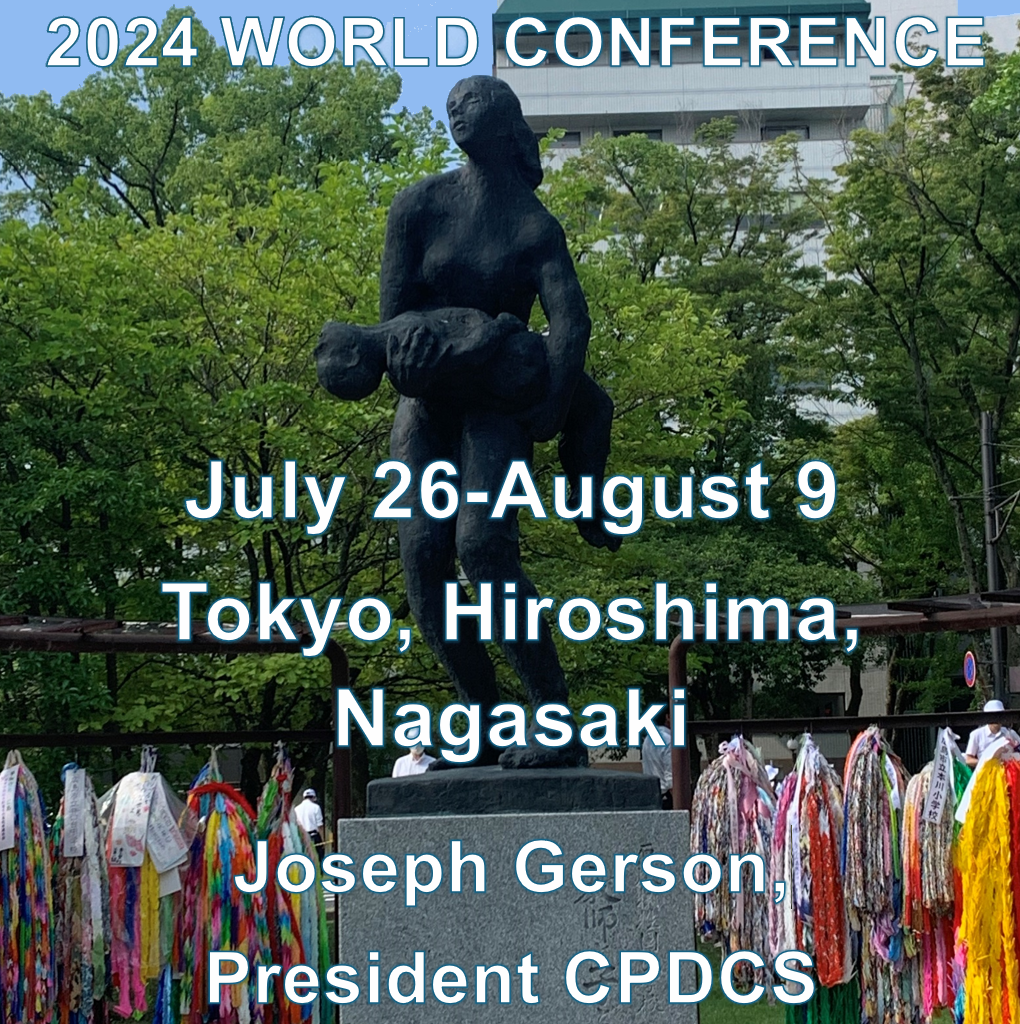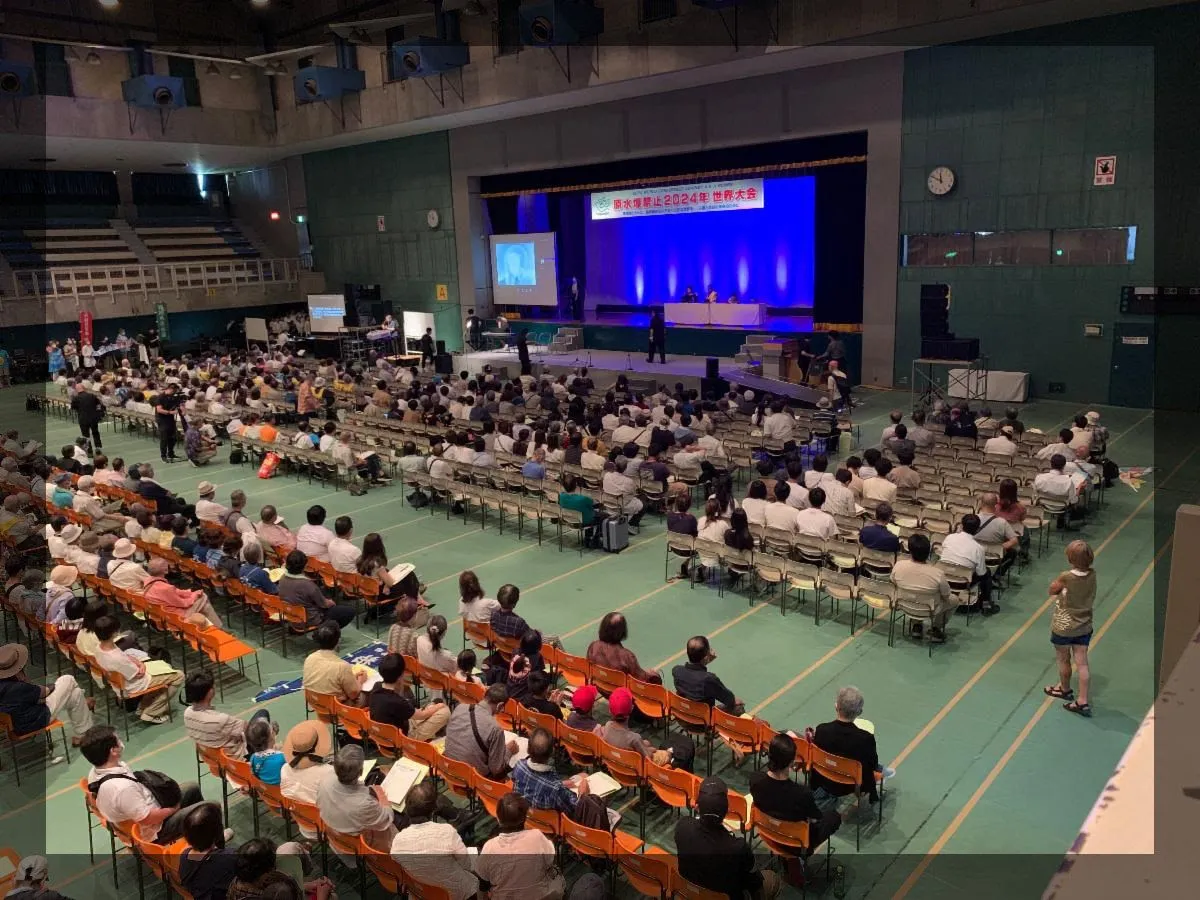
| This is not a comprehensive report. It includes a number of highlights and references to key points in a number of speeches during Gensuikyo’s World Conference against A- & H- Bombs held in Hiroshima and Nagasaki August 2-9. By way of background, held annually since 1955, the World Conference has been a keystone event for the Japanese nuclear disarmament and peace movement, which continues to be an essential social movement with deep resonance in Japanese political and social culture. In addition to bringing several thousand activists and students for conferences, rallies, workshops, and the official Hiroshima ceremony (@ 4,000 this year), it also brings together diplomats whose countries advocate nuclear weapons abolition, leading movement figure from Asia, Europe, and the United States.[i] The conference, and Hiroshima Declaration (I played a small role in drafting it, which was posted to the CPDCS Elist, and from there by Pressenza and shared by others), serves as the foundation for activities across Japan for the coming year. It also provides some direction, and certainly inspiration, for the internationals who participate and their organizations. The conference focuses on preventing nuclear war, eliminating nuclear weapons, and provision of support for Hibakusha. The two primary – and repeated – foci at this year’s conference were support for the Treaty on Prohibition of Nuclear Weapons and preparation for the 80th anniversary of the A-bombings in 2025. A million and a half petition signatures urging Japan to join the TPNW have been collected so far, with 40% of municipalities and a majority of governors (even some conservatives) having endorsed the call for Japan to join the TPNW. It is reported that 70% of Japanese support Japan joining the TPNW. With the average age of Hibakusha now being 85.5 years old, there is a deepening appreciation of what will be lost as the last of them die. It is believed that given their ages, the 80th anniversary will provide the last opportunity for them to send their ringing warning that nuclear weapons must be abolished: “Human beings and nuclear weapons cannot coexist.” Note as well that even second generation Hibakusha are now getting older, with some in their 70’s. Among the differences from conferences in the past was the focus on the increasing reliance of U.S. allies and the US on extended nuclear deterrence which increases the danger of nuclear war. Russia too has increased its reliance on nuclear weapons. There were many references by Japanese (including Hibakusha) and by international speakers to the Gaza and Ukraine Wars and their potentials to trigger escalations to wider – even nuclear – war. Tanaka Terumi, the co-chair and former general secretary of Hidankyo (the Japan Confederation of A- & H- Bomb Sufferers Organizations) said that Israel is attempting to exterminate Palestinians. There was a diplomatic kerfuffle when the mayor of Nagasaki disinvited Israel’s official representative to the city’s official ceremony. The G-7 responded by not attending, and Japan’s equivalent of the New York Times editorialized that, “… while the Group of Seven countries condemn Russia, their response to Israel’s ruthless military actions with little attention to humanitarian concerns, remains tepid. By not attending the Nagasaki ceremony, the American and British envoys brought this ethical “double standard” to the A-bomb arena.” In the wake of Prime Minister Abe’s assassination and the attempt on Trump’s life security was tighter for the official Hiroshima commemoration than at an airport. In the blazing sun, we had four different inspections and had to switch lines back and forth. Given Mayor Matsui’s tepid Declaration, the high point of which was his call for Japan to join the TPNW, the dehumanization of the inspections hardly seemed worth the suffering. That said, the media did report that a call for peace had gone out from Hiroshima. There were also numerous condemnations of the LDP government’s expanding military commitments and the deepening integration of the Japanese and U.S. militaries for “seamless” joint operations, The new joint command likely to be led by a U.S. general. In the Japanese peace movement, this is seen as deepening Japanese subservience to the U.S. and the deepening U.S.-Japan-South Korean alliance which was secretly imposed on Japan in 1952 as a condition for ending the post-war military occupation. Other differences included an increased reliance on video and zoom talks. They included talks by Ambassador Kmentt (the Austrian “father” of the TPNW), several European movement leaders, and by Terumi Tanaka. International civil society participants were 72 in number. There was a much larger South Korean delegation than in the past, mostly from SPARK, as well as Korean hibakusha. They are planning an international tribunal about the A-bombings of Koreans in Hiroshima and Nagasaki. |
| My roles were meeting colleagues in Tokyo, supporting my grandson for an interview for the New Japan Women’s Association’s newspaper (Shinfujin has @ 200,000 members) about the progressive curricula at the Cambridge high school to encourage gender respect and feminist history and values. I co-chaired and was a keynote speaker at Gensuikyo’s international conference, which brought together about 250 Japanese movement leaders and internationals. I spoke in the Hiroshima rally (about 3,500 people), in 2 workshops about grassroots organizing for the TPNW and with Minister Batyrkhan Kurmanseit of the Kazakh embassy (whose ambassador will chair of the 2025 3rd meeting of states parties of the TPNW) and a Mexican diplomat. I also was a keynote speaker in a program at Nagasaki University. Several points raised in the International Conference and workshops: I was impressed by the depth of the talk by the Kazakh embassy councilor. He focused on the USSR’s disastrous abuse of 468 nuclear weapons tests at Semipalatinsk, which is about 20 times the size of Hiroshima. This has led Kazakhstan to take the lead in working to prevent future nuclear weapons tests and to serve as the chair for the 3rd TPNW Meeting of States Parties in 2025. A contradiction, he noted, is that Kazakhstan is the world’s leading producer of uranium for nuclear power plants. This has caused divisions within Kazakhstan, especially between younger and older generations, and in response there will be a referendum. I am always deeply moved by the talks of Abacca Anjain Madison of the Marshall Islands, where the U.S. conducted more than 60 nuclear weapons tests, and still uses Kwajalein atoll as the target for ICBM missile tests. The isolation, poverty, and dependence on the U.S. of the Marshall Islands – with only 50,000 people – is heart rending. It always brings to mind the Cowboys and Indians paradigm of extreme abuse rooted in racism as well as militarism. Yayoi Tsuchida of Gensuikyo reported with her participation in July’s NPT PrepCom. She spoke about the first day’s criticisms of Russian’s invasion of Ukraine, the deployment of Russian nuclear weapons to Belarus, and Russia’s nuclear weapons exercises. Russia, she said, seemed isolated. With sarcasm she reported that the U.S. stated that it is working for peace and disarmament with no mention of Gaza. Needless to say, she also expressed frustration about the PrepCom’s lack of progress toward the nuclear weapons states fulfilling their Article VI commitment to good faith negotiations for the complete elimination of the world’s nuclear arsenals. Kate Hudson of Britian’s CND spoke via video recording and focused on the dangers of the Gaza and Ukraine Wars and the increasing nuclearization of NATO, including deployment of new B-61-12 nuclear warheads to Britain. As several others did, she asserted that we are in a pre-war, not post-war world. I was impressed by the report by Maribel Hernandez, the young director of the Alliance for Nuclear Disarmament in Spain. They have a broad and diverse coalition of about 60 organizations who are pressing for Span to join the TPNW. The previous platform of the now ruling Spanish Socialist Party called for joining the TPNW, but they have backed off. Her talks also focused on the 1966 Palomares nuclear accident in which 2 A-bombs fell from a U.S. bomber with serious health impacts on nearby communities.Heinz Bierbaum, Chair of the Board of the Rosa Luxemburg Foundation, gave what I thought was a deeply grounded speech about the multi crises facing humanity: military, economic, environmental, and cultural, not the least being the emergence of the new bloc system. In rally speeches Solidarity messages were received from the Lao, Vietnamese, Austrian, and Irish governments and the International Committee of the Red Cross. I was surprised and impressed by a message from the former CEO of Google in Japan. He condemned Japan’s increasing militarization including the goal of 2% GDP military spending and the export of weapons. Technology, he urged, should be used only for civilian purposes. Japan, he said, with its massive turn back to militarism is becoming “strange,” And those involved in the LDP’s funding scandal should have been indicted.Diplomats from Austria, Indonesia, Kazakhstan, and Cuba, and U.N. High Representative for Disarmament Izumi Nakamitsu addressed rallies either in person or via video.In a video statement, Austrian ambassador Kmentt addressed the “bleak outlook” and condemned the nuclear powers threats and nuclear modernization for the long-term, their abandoning previous arms control agreements, and the deployments of new intermediate range missiles (in Europe and Asia-Pacific.) He pointed to the nuclear threats in Ukraine, Korea, South China Sea, Taiwan, and South Asia, and spoke about the limitations of deterrence. The way out he asserted is building the TPNW.The representative from the Indonesian embassy spoke of her country having joined the TPNW, its importance, and the need to stop the killing in Gaza. Okinawans (and others) condemned the recent US and Japanese cover ups of sexual assaults against Okinawan women. (This has been a brutal pattern since the U.S. occupation of Okinawa began in 1945. Also condemned the continuing construction of a massive new U.S. naval and air base at Heneko, and the Japanese military buildup in Okinawa and its remote islands in preparation for a possible war over Taiwan. Additional notes: The Japan Communist Party, which has a long had members in the Japanese Diet, has articulated a comprehensive policy, essentially consistent with our Common Security recommendations, which it is advocating. The former head of the JCP, Shii, recently met with senior Chinese Communist officials and urged a common security policy. Osaka is ruled by the Japan Restoration Party, a fascist party to the right of the LDP. On August 8 there was a major earthquake in the Nankai Trough. No one was hurt, but in the past earthquakes in that location have triggered megaquakes. This led Prime Minister Kishida to cancel plans to visit several countries so that he could be in Japan in case of a major quake and emergency. While some people horded supplies against a possible megaquake, life proceeded largely as usual, with many people traveling for the Obon holiday. On the subject of Kishida, he is about as unpopular as Biden was before he withdrew from the election. Not unlike Biden, in mid-August he announced that in September he would step aside for another LDP leader to become prime minister. The opposition Constitutional Democratic Party is more hopeful than in the recent past that they have a chance of defeating the LDP (but don’t get your hopes too high!). |
| [i] In addition to diplomats and the United Nations, civil society participants came from Australia, France, Germany, India, Marshall Islands, Nepal, The Philippines, Republic of Korea, Spain, Russia, Vietnam, United Kingdom, United States, ICAN, IPB, and WILPF |

